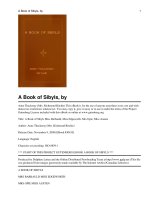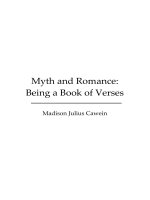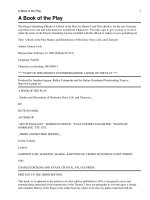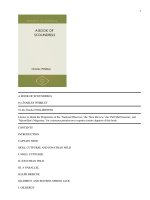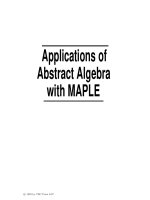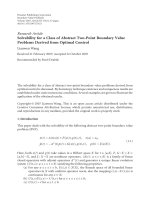a book of ABStract algebra 2nd
Bạn đang xem bản rút gọn của tài liệu. Xem và tải ngay bản đầy đủ của tài liệu tại đây (6.63 MB, 358 trang )
ABOOKOF
ABSTRACTALGEBRA
SecondEdition
CharlesC.Pinter
ProfessorofMathematics
BucknellUniversity
DoverPublications,Inc.,Mineola,NewYork
Copyright
Copyright©1982,1990byCharlesC.Pinter
Allrightsreserved.
BibliographicalNote
ThisDoveredition,firstpublishedin2010,isanunabridgedrepublicationofthe1990secondeditionoftheworkoriginallypublishedin1982
bytheMcGraw-HillPublishingCompany,Inc.,NewYork.
LibraryofCongressCataloging-in-PublicationData
Pinter,CharlesC,1932–
Abookofabstractalgebra/CharlesC.Pinter.—Dovered.
p.cm.
Originallypublished:2nded.NewYork:McGraw-Hill,1990.
Includesbibliographicalreferencesandindex.
ISBN-13:978-0-486-47417-5
ISBN-10:0-486-47417-8
1.Algebra,Abstract.I.Title.
QA162.P562010
512′.02—dc22
2009026228
ManufacturedintheUnitedStatesbyCourierCorporation
47417803
www.doverpublications.com
Tomywife,Donna,
andmysons,
Nicholas,Marco,
Andrés,andAdrian
CONTENTS*
Preface
Chapter 1 WhyAbstractAlgebra?
HistoryofAlgebra.NewAlgebras.AlgebraicStructures.AxiomsandAxiomaticAlgebra.
AbstractioninAlgebra.
Chapter 2 Operations
OperationsonaSet.PropertiesofOperations.
Chapter 3 TheDefinitionofGroups
Groups.ExamplesofInfiniteandFiniteGroups.ExamplesofAbelianandNonabelian
Groups.GroupTables.
TheoryofCoding:Maximum-LikelihoodDecoding.
Chapter 4 ElementaryPropertiesofGroups
UniquenessofIdentityandInverses.PropertiesofInverses.
DirectProductofGroups.
Chapter 5 Subgroups
DefinitionofSubgroup.GeneratorsandDefiningRelations.
CayleyDiagrams.CenterofaGroup.GroupCodes;HammingCode.
Chapter 6 Functions
Injective,Surjective,BijectiveFunction.CompositeandInverseofFunctions.
Finite-StateMachines.AutomataandTheirSemigroups.
Chapter 7 GroupsofPermutations
SymmetricGroups.DihedralGroups.
AnApplicationofGroupstoAnthropology.
Chapter 8 PermutationsofaFiniteSet
DecompositionofPermutationsintoCycles.Transpositions.EvenandOddPermutations.
AlternatingGroups.
Chapter 9 Isomorphism
TheConceptofIsomorphisminMathematics.IsomorphicandNonisomorphicGroups.
Cayley’sTheorem.
GroupAutomorphisms.
Chapter 10 OrderofGroupElements
Powers/MultiplesofGroupElements.LawsofExponents.PropertiesoftheOrderofGroup
Elements.
Chapter 11 CyclicGroups
FiniteandInfiniteCyclicGroups.IsomorphismofCyclicGroups.SubgroupsofCyclic
Groups.
Chapter 12 PartitionsandEquivalenceRelations
Chapter 13 CountingCosets
Lagrange’sTheoremandElementaryConsequences.
SurveyofGroupsofOrder≤10.
NumberofConjugateElements.GroupActingonaSet.
Chapter 14 Homomorphisms
ElementaryPropertiesofHomomorphisms.NormalSubgroups.KernelandRange.
InnerDirectProducts.ConjugateSubgroups.
Chapter 15 QuotientGroups
QuotientGroupConstruction.ExamplesandApplications.
TheClassEquation.InductionontheOrderofaGroup.
Chapter 16 TheFundamentalHomomorphismTheorem
FundamentalHomomorphismTheoremandSomeConsequences.
TheIsomorphismTheorems.TheCorrespondenceTheorem.Cauchy’sTheorem.Sylow
Subgroups.Sylow’sTheorem.DecompositionTheoremforFiniteAbelianGroups.
Chapter 17 Rings:DefinitionsandElementaryProperties
CommutativeRings.Unity.InvertiblesandZero-Divisors.IntegralDomain.Field.
Chapter 18 IdealsandHomomorphisms
Chapter 19 QuotientRings
ConstructionofQuotientRings.Examples.FundamentalHomomorphismTheoremand
SomeConsequences.PropertiesofPrimeandMaximalIdeals.
Chapter 20 IntegralDomains
CharacteristicofanIntegralDomain.PropertiesoftheCharacteristic.FiniteFields.
ConstructionoftheFieldofQuotients.
Chapter 21 TheIntegers
OrderedIntegralDomains.Well-ordering.Characterizationof UptoIsomorphism.
MathematicalInduction.DivisionAlgorithm.
Chapter 22 FactoringintoPrimes
Idealsof .PropertiesoftheGCD.RelativelyPrimeIntegers.Primes.Euclid’sLemma.
UniqueFactorization.
Chapter 23 ElementsofNumberTheory(Optional)
PropertiesofCongruence.TheoremsofFermâtandEuler.SolutionsofLinearCongruences.
ChineseRemainderTheorem.
Wilson’sTheoremandConsequences.QuadraticResidues.TheLegendreSymbol.
PrimitiveRoots.
Chapter 24 RingsofPolynomials
MotivationandDefinitions.DomainofPolynomialsoveraField.DivisionAlgorithm.
PolynomialsinSeveralVariables.FieldsofPolynomialQuotients.
Chapter 25 FactoringPolynomials
IdealsofF[x].PropertiesoftheGCD.IrreduciblePolynomials.Uniquefactorization.
EuclideanAlgorithm.
Chapter 26 SubstitutioninPolynomials
RootsandFactors.PolynomialFunctions.Polynomialsover .Eisenstein’sIrreducibility
Criterion.PolynomialsovertheReals.PolynomialInterpolation.
Chapter 27 ExtensionsofFields
AlgebraicandTranscendentalElements.TheMinimumPolynomial.BasicTheoremon
FieldExtensions.
Chapter 28 VectorSpaces
ElementaryPropertiesofVectorSpaces.LinearIndependence.Basis.Dimension.Linear
Transformations.
Chapter 29 DegreesofFieldExtensions
SimpleandIteratedExtensions.DegreeofanIteratedExtension.
FieldsofAlgebraicElements.AlgebraicNumbers.AlgebraicClosure.
Chapter 30 RulerandCompass
ConstructiblePointsandNumbers.ImpossibleConstructions.
ConstructibleAnglesandPolygons.
Chapter 31 GaloisTheory:Preamble
MultipleRoots.RootField.ExtensionofaField.Isomorphism.
RootsofUnity.SeparablePolynomials.NormalExtensions.
Chapter 32 GaloisTheory:TheHeartoftheMatter
FieldAutomorphisms.TheGaloisGroup.TheGaloisCorrespondence.Fundamental
TheoremofGaloisTheory.
ComputingGaloisGroups.
Chapter 33 SolvingEquationsbyRadicals
RadicalExtensions.AbelianExtensions.SolvableGroups.InsolvabilityoftheQuintic.
AppendixA ReviewofSetTheory
AppendixB ReviewoftheIntegers
AppendixC ReviewofMathematicalInduction
AnswerstoSelectedExercises
Index
*Italicheadingsindicatetopicsdiscussedintheexercisesections.
PREFACE
Once,whenIwasastudentstrugglingtounderstandmodernalgebra,Iwastoldtoviewthissubjectasan
intellectualchessgame,withconventionalmovesandprescribedrulesofplay.Iwasillservedbythisbit
ofextemporaneousadvice,andvowednevertoperpetuatethefalsehoodthatmathematicsispurely—or
primarily—aformalism.Mypledgehasstronglyinfluencedtheshapeandstyleofthisbook.
While giving due emphasis to the deductive aspect of modern algebra, I have endeavored here to
present modern algebra as a lively branch of mathematics, having considerable imaginative appeal and
restingonsomefirm,clear,andfamiliarintuitions.Ihavedevotedagreatdealofattentiontobringingout
themeaningfulnessofalgebraicconcepts,bytracingtheseconceptstotheiroriginsinclassicalalgebra
and at the same time exploring their connections with other parts of mathematics, especially geometry,
numbertheory,andaspectsofcomputationandequationsolving.
InanintroductorychapterentitledWhyAbstractAlgebra?,aswellasinnumeroushistoricalasides,
concepts of abstract algebra are traced to the historic context in which they arose. I have attempted to
showthattheyarosewithoutartifice,asanaturalresponsetoparticularneeds,inthecourseofanatural
processofevolution.Furthermore,Ihaveendeavoredtobringtolight,explicitly,theintuitivecontentof
thealgebraicconceptsusedinthisbook.Conceptsaremoremeaningfultostudentswhenthestudentsare
able to represent those concepts in their minds by clear and familiar mental images. Accordingly, the
processofconcreteconcept-formationisdevelopedwithcarethroughoutthisbook.
Ihavedeliberatelyavoidedarigidconventionalformat,withitssuccessionofdefinition, theorem,
proof,corollary,example.Inmyexperience,thatkindofformatencouragessomestudentstobelievethat
mathematical concepts have a merely conventional character, and may encourage rote memorization.
Instead, each chapter has the form of a discussion with the student, with the accent on explaining and
motivating.
Inanefforttoavoidfragmentationofthesubjectmatterintolooselyrelateddefinitionsandresults,
eachchapterisbuiltaroundacentralthemeandremainsanchoredtothisfocalpoint.Inthelaterchapters
especially,thisfocalpointisaspecificapplicationoruse.Detailsofeverytopicarethenwovenintothe
generaldiscussion,soastokeepanaturalflowofideasrunningthrougheachchapter.
The arrangement of topics is designed to avoid tedious proofs and long-winded explanations.
Routine arguments are worked into the discussion whenever this seems natural and appropriate, and
proofstotheoremsareseldommorethanafewlineslong.(Thereare,ofcourse,afewexceptionstothis.)
Elementary background material is filled in as it is needed. For example, a brief chapter on functions
precedes the discussion of permutation groups, and a chapter on equivalence relations and partitions
pavesthewayforLagrange’stheorem.
This book addresses itself especially to the average student, to enable him or her to learn and
understand as much algebra as possible. In scope and subject-matter coverage, it is no different from
manyotherstandardtexts.Itbeginswiththepromiseofdemonstratingtheunsolvabilityofthequinticand
endswiththatpromisefulfilled.Standardtopicsarediscussedintheirusualorder,andmanyadvanced
and peripheral subjects are introduced in the exercises, accompanied by ample instruction and
commentary.
Ihaveincludedacopioussupplyofexercises—probablymoreexercisesthaninotherbooksatthis
level. They are designed to offer a wide range of experiences to students at different levels of ability.
Thereissomenoveltyinthewaytheexercisesareorganized:attheendofeachchapter,theexercisesare
groupedintoexercisesets,eachsetcontainingaboutsixtoeightexercisesandheadedbyadescriptive
title.Eachsettouchesuponanideaorskillcoveredinthechapter.
Thefirstfewexercisesetsineachchaptercontainproblemswhichareessentiallycomputationalor
manipulative.Then,therearetwoorthreesetsofsimpleproof-typequestions,whichrequiremainlythe
ability to put together definitions and results with understanding of their meaning. After that, I have
endeavoredtomaketheexercisesmoreinterestingbyarrangingthemsothatineachsetanewresultis
proved,ornewlightisshedonthesubjectofthechapter.
As a rule, all the exercises have the same weight: very simple exercises are grouped together as
partsofasingleproblem,andconversely,problemswhichrequireacomplexargumentarebrokeninto
severalsubproblemswhichthestudentmaytackleinturn.Ihaveselectedmainlyproblemswhichhave
intrinsic relevance, and are not merely drill, on the premise that this is much more satisfying to the
student.
CHANGESINTHESECONDEDITION
During the seven years that have elapsed since publication of the first edition of A Book of Abstract
Algebra,Ihavereceivedlettersfrommanyreaderswithcommentsandsuggestions.Moreover,anumber
ofreviewershavegoneoverthetextwiththeaimoffindingwaystoincreaseitseffectivenessandappeal
asateachingtool.Inpreparingthesecondedition,Ihavetakenaccountofthemanysuggestionsthatwere
made,andofmyownexperiencewiththebookinmyclasses.
Inadditiontonumeroussmallchangesthatshouldmakethebookeasiertoread,thefollowingmajor
changesshouldbenoted:
EXERCISES Many of the exercises have been refined or reworded—and a few of the exercise sets
reorganized—in order to enhance their clarity or, in some cases, to make them more mathematically
interesting.Inaddition,severalnewexericsesetshavebeenincludedwhichtouchuponapplicationsof
algebraandarediscussednext:
APPLICATIONSThequestionofincluding“applications”ofabstractalgebrainanundergraduatecourse
(especiallyaone-semestercourse)isatouchyone.Eitheronerunstheriskofmakingavisiblyweakcase
for the applicability of the notions of abstract algebra, or on the other hand—by including substantive
applications—onemayenduphavingtoomitalotofimportantalgebra.IhaveadoptedwhatIbelieveis
areasonablecompromisebyaddinganelementarydiscussionofafewapplicationareas(chieflyaspects
ofcodingandautomatatheory)onlyintheexercisesections,inconnectionwithspecificexercise.These
exercisesmaybeeitherstressed,de-emphasized,oromittedaltogether.
PRELIMINARIESItmaywellbearguedthat,inordertoguaranteethesmootheflowandcontinuityofa
course in abstract algebra, the course should begin with a review of such preliminaries as set theory,
inductionandthepropertiesofintegers.Inordertoprovidematerialforteacherswhoprefertostartthe
courseinthisfashion,IhaveaddedanAppendixwiththreebriefchaptersonSets,IntegersandInduction,
respectively,eachwithitsownsetofexercises.
SOLUTIONSTOSELECTEDEXERCISESAfewexercisesineachchapteraremarkedwiththesymbol
#.Thisindicatesthatapartialsolution,orsometimesmerelyadecisivehint,aregivenattheendofthe
bookinthesectiontitledSolutionstoSelectedExercises.
ACKNOWLEDGMENTS
Iwouldliketoexpressmythanksforthemanyusefulcommentsandsuggestionsprovidedbycolleagues
whoreviewedthistextduringthecourseofthisrevision,especiallytoJ.RichardByrne,PortlandState
University: D. R. LaTorre, Clemson University; Kazem Mahdavi, State University College at Potsdam;
ThomasN.Roe,SouthDakotaStateUniversity;andArmondE.Spencer,StateUniversityofNewYorkPotsdam.Inparticular,IwouldliketothankRobertWeinstein,mathematicseditoratMcGraw-Hillduring
the preparation of the second edition of this book. I am indebted to him for his guidance, insight, and
steadyencouragement.
CharlesC.Pinter
CHAPTER
ONE
WHYABSTRACTALGEBRA?
Whenweopenatextbookofabstractalgebraforthefirsttimeandperusethetableofcontents,weare
struckbytheunfamiliarityofalmosteverytopicweseelisted.Algebraisasubjectweknowwell,but
hereitlookssurprisinglydifferent.Whatarethesedifferences,andhowfundamentalarethey?
First,thereisamajordifferenceinemphasis.Inelementaryalgebrawelearnedthebasicsymbolism
andmethodologyofalgebra;wecametoseehowproblemsoftherealworldcanbereducedtosetsof
equations and how these equations can be solved to yield numerical answers. This technique for
translating complicated problems into symbols is the basis for all further work in mathematics and the
exactsciences,andisoneofthetriumphsofthehumanmind.However,algebraisnotonlyatechnique,it
isalsoabranchoflearning,adiscipline,likecalculusorphysicsorchemistry.Itisacoherentandunified
bodyofknowledgewhichmaybestudiedsystematically,startingfromfirstprinciplesandbuildingup.So
the first difference between the elementary and the more advanced course in algebra is that, whereas
earlierweconcentratedontechnique,wewillnowdevelopthatbranchofmathematicscalledalgebrain
asystematicway.Ideasandgeneralprincipleswilltakeprecedenceoverproblemsolving.(Bytheway,
this does not mean that modern algebra has no applications—quite the opposite is true, as we will see
soon.)
Algebraatthemoreadvancedlevelisoftendescribedasmodernorabstractalgebra.Infact,both
ofthesedescriptionsarepartlymisleading.Someofthegreatdiscoveriesintheupperreachesofpresentdayalgebra(forexample,theso-calledGaloistheory)wereknownmanyyearsbeforetheAmericanCivil
War;andthebroadaimsofalgebratodaywereclearlystatedbyLeibnizintheseventeenthcentury.Thus,
“modern”algebraisnotsoverymodern,afterall!Towhatextentisitabstract?Well,abstractionisall
relative; one person’s abstraction is another person’s bread and butter. The abstract tendency in
mathematicsisalittlelikethesituationofchangingmoralcodes,orchangingtastesinmusic:Whatshocks
onegenerationbecomesthenorminthenext.Thishasbeentruethroughoutthehistoryofmathematics.
Forexample,1000yearsagonegativenumberswereconsideredtobeanoutrageousidea.Afterall,
itwassaid,numbersareforcounting:wemayhaveoneorange,ortwooranges,ornoorangesatall;but
how can we have minus an orange? The logisticians, or professional calculators, of those days used
negativenumbersasanaidintheircomputations;theyconsideredthesenumberstobeausefulfiction,for
ifyoubelieveinthemtheneverylinearequationax+b=0hasasolution(namelyx=−b/a,provideda≠
0).EventhegreatDiophantusoncedescribedthesolutionof4x+6=2asanabsurdnumber.Theideaof
a system of numeration which included negative numbers was far too abstract for many of the learned
headsofthetenthcentury!
The history of the complex numbers (numbers which involve
) is very much the same. For
hundredsofyears,mathematiciansrefusedtoacceptthembecausetheycouldn’tfindconcreteexamplesor
applications.(Theyarenowabasictoolofphysics.)
Settheorywasconsideredtobehighlyabstractafewyearsago,andsowereothercommonplacesof
today. Many of the abstractions of modern algebra are already being used by scientists, engineers, and
computerspecialistsintheireverydaywork.Theywillsoonbecommonfare,respectably“concrete,”and
bythentherewillbenew“abstractions.”
Laterinthischapterwewilltakeacloserlookattheparticularbrandofabstractionusedinalgebra.
Wewillconsiderhowitcameaboutandwhyitisuseful.
Algebrahasevolvedconsiderably,especiallyduringthepast100years.Itsgrowthhasbeenclosely
linked with the development of other branches of mathematics, and it has been deeply influenced by
philosophicalideasonthenatureofmathematicsandtheroleoflogic.Tohelpusunderstandthenature
andspiritofmodernalgebra,weshouldtakeabrieflookatitsorigins.
ORIGINS
Theorderinwhichsubjectsfolloweachotherinourmathematicaleducationtendstorepeatthehistorical
stages in the evolution of mathematics. In this scheme, elementary algebra corresponds to the great
classicalageofalgebra,whichspansabout300yearsfromthesixteenththroughtheeighteenthcenturies.
It was during these years that the art of solving equations became highly developed and modern
symbolismwasinvented.
The word “algebra”—al jebr in Arabic—was first used by Mohammed of Kharizm, who taught
mathematicsinBaghdadduringtheninthcentury.Thewordmayberoughlytranslatedas“reunion,”and
describeshismethodforcollectingthetermsofanequationinordertosolveit.Itisanamusingfactthat
the word “algebra” was first used in Europe in quite another context. In Spain barbers were called
algebristas,orbonesetters(theyreunitedbrokenbones),becausemedievalbarbersdidbonesettingand
bloodlettingasasidelinetotheirusualbusiness.
Theoriginofthewordclearlyreflectstheactualcontextofalgebraatthattime,foritwasmainly
concerned with ways of solving equations. In fact, Omar Khayyam, who is best remembered for his
brilliantversesonwine,song,love,andfriendshipwhicharecollectedintheRubaiyat—but who was
alsoagreatmathematician—explicitlydefinedalgebraasthescienceofsolvingequations.
Thus, as we enter upon the threshold of the classical age of algebra, its central theme is clearly
identifiedasthatofsolvingequations.Methodsofsolvingthelinearequationax+b=0andthequadratic
ax2+bx+c=0werewellknownevenbeforetheGreeks.Butnobodyhadyetfoundageneralsolution
forcubicequations
x3+ax2+bx=c
orquartic(fourth-degree)equations
x4+ax3+bx2+cx=d
Thisgreataccomplishmentwasthetriumphofsixteenthcenturyalgebra.
The setting is Italy and the time is the Renaissance—an age of high adventure and brilliant
achievement,whenthewideworldwasreawakeningafterthelongausterityoftheMiddleAges.America
hadjustbeendiscovered,classicalknowledgehadbeenbroughttolight,andprosperityhadreturnedto
thegreatcitiesofEurope.Itwasaheadyagewhennothingseemedimpossibleandeventheoldbarriers
of birth and rank could be overcome. Courageous individuals set out for great adventures in the far
cornersoftheearth,whileothers,nowconfidentonceagainofthepowerofthehumanmind,wereboldly
exploringthelimitsofknowledgeinthesciencesandthearts.Theidealwastobeboldandmany-faceted,
to“knowsomethingofeverything,andeverythingofatleastonething.”Thegreattraderswerepatronsof
thearts,thefinestmindsinsciencewereadeptsatpoliticalintrigueandhighfinance.Thestudyofalgebra
wasreborninthislivelymilieu.
Thosemenwhobroughtalgebratoahighlevelofperfectionatthebeginningofitsclassicalage—all
typical products of the Italian Renaissanee —were as colorful and extraordinary a lot as have ever
appeared in a chapter of history. Arrogant and unscrupulous, brilliant, flamboyant, swaggering, and
remarkable,theylivedtheirlivesastheydidtheirwork:withstyleandpanache,inbrilliantdashesand
inspiredleapsoftheimagination.
The spirit of scholarship was not exactly as it is today. These men, instead of publishing their
discoveries, kept them as well-guarded secrets to be used against each other in problem-solving
competitions. Such contests were a popular attraction: heavy bets were made on the rival parties, and
theirreputations(aswellasasubstantialpurse)dependedontheoutcome.
One of the most remarkable of these men was Girolamo Cardan. Cardan was born in 1501 as the
illegitimatesonofafamousjuristofthecityofPavia.Amanofpassionatecontrasts,hewasdestinedto
becomefamousasaphysician,astrologer,andmathematician—andnotoriousasacompulsivegambler,
scoundrel,andheretic.Afterhegraduatedinmedicine,hiseffortstobuildupamedicalpracticewereso
unsuccessfulthatheandhiswifewereforcedtoseekrefugeinthepoorhouse.Withthehelpoffriendshe
became a lecturer in mathematics, and, after he cured the child of a senator from Milan, his medical
careeralsopickedup.Hewasfinallyadmittedtothecollegeofphysiciansandsoonbecameitsrector.A
brilliantdoctor,hegavethefirstclinicaldescriptionoftyphusfever,andashisfamespreadhebecame
thepersonalphysicianofmanyofthehighandmightyofhisday.
Cardan’searlyinterestinmathematicswasnotwithoutapracticalside.Asaninveterategamblerhe
was fascinated by what he recognized to be the laws of chance. He wrote a gamblers’ manual entitled
Book on Games of Chance, which presents the first systematic computations of probabilities. He also
needed mathematics as a tool in casting horoscopes, for his fame as an astrologer was great and his
predictionswerehighlyregardedandsoughtafter.Hismostimportantachievementwasthepublicationof
a book called Ars Magna (The Great Art), in which he presented systematically all the algebraic
knowledgeofhistime.However,asalreadystated,muchofthisknowledgewasthepersonalsecretofits
practitioners, and had to be wheedled out of them by cunning and deceit. The most important
accomplishment of the day, the general solution of the cubic equation which had been discovered by
Tartaglia,wasobtainedinthatfashion.
Tartaglia’slifewasasturbulentasanyinthosedays.BornwiththenameofNiccoloFontanaabout
1500,hewaspresentattheoccupationofBresciabytheFrenchin1512.Heandhisfatherfledwithmany
othersintoacathedralforsanctuary,butintheheatofbattlethesoldiersmassacredthehaplesscitizens
eveninthatholyplace.Thefatherwaskilled,andtheboy,withasplitskullandadeepsabercutacross
hisjawsandpalate,wasleftfordead.Atnighthismotherstoleintothecathedralandmanagedtocarry
himoff;miraculouslyhesurvived.Thehorrorofwhathehadwitnessedcausedhimtostammerforthe
restofhislife,earninghimthenicknameTartaglia,“thestammerer,”whichheeventuallyadopted.
Tartaglia received no formal schooling, for that was a privilege of rank and wealth. However, he
taught himself mathematics and became one of the most gifted mathematicians of his day. He translated
Euclid and Archimedes and may be said to have originated the science of ballistics, for he wrote a
treatiseongunnerywhichwasapioneeringeffortonthelawsoffallingbodies.
In1535Tartagliafoundawayofsolvinganycubicequationoftheformx3+ax2=b(thatis,without
an x term). When be announced his accomplishment (without giving any details, of course), he was
challenged to an algebra contest by a certain Antonio Fior, a pupil of the celebrated professor of
mathematicsScipiodelFerro.Scipiohadalreadyfoundamethodforsolvinganycubicequationofthe
formx3+ax=b(thatis,withoutanx2term),andhadconfidedhissecrettohispupilFior.Itwasagreed
thateachcontestantwastodrawup30problemsandhandthelisttohisopponent.Whoeversolvedthe
greaternumberofproblemswouldreceiveasumofmoneydepositedwithalawyer.Afewdaysbefore
thecontest,Tartagliafoundawayofextendinghismethodsoastosolveanycubicequation.Inlessthan2
hours he solved all his opponent’s problems, while his opponent failed to solve even one of those
proposedbyTartaglia.
For some time Tartaglia kept his method for solving cubic equations to himself, but in the end he
succumbedtoCardan’saccomplishedpowersofpersuasion.InfluencedbyCardan’spromisetohelphim
becomeartilleryadvisertotheSpanisharmy,herevealedthedetailsofhismethodtoCardanunderthe
promiseofstrictsecrecy.Afewyearslater,toTartaglia’sunbelievingamazementandindignation,Cardan
published Tartaglia’s method in his book Ars Magna. Even though he gave Tartaglia full credit as the
originatorofthemethod,therecanbenodoubtthathebrokehissolemnpromise.Abitterdisputearose
betweenthemathematicians,fromwhichTartagliawasperhapsluckytoescapealive.Helosthisposition
aspubliclectureratBrescia,andlivedouthisremainingyearsinobscurity.
Thenextgreatstepintheprogressofalgebrawasmadebyanothermemberofthesamecircle.Itwas
Ludovico Ferrari who discovered the general method for solving quartic equations—equations of the
form
x4+ax3+bx2+cx=d
Ferrari was Cardan’s personal servant. As a boy in Cardan’s service he learned Latin, Greek, and
mathematics.HewonfameafterdefeatingTartagliainacontestin1548,andreceivedanappointmentas
supervisoroftaxassessmentsinMantua.Thispositionbroughthimwealthandinfluence,buthewasnot
abletodominatehisownviolentdisposition.HequarreledwiththeregentofMantua,losthisposition,
anddiedattheageof43.Traditionhasitthathewaspoisonedbyhissister.
As for Cardan, after a long career of brilliant and unscrupulous achievement, his luck finally
abandoned him. Cardan’s son poisoned his unfaithful wife and was executed in 1560. Ten years later,
Cardan was arrested for heresy because he published a horoscope of Christ’s life. He spent several
monthsinjailandwasreleasedafterrenouncinghisheresyprivately,butlosthisuniversitypositionand
the right to publish books. He was left with a small pension which had been granted to him, for some
unaccountablereason,bythePope.
Asthiscolorfultimedrawstoaclose,algebraemergesasamajorbranchofmathematics.Itbecame
clear that methods can be found to solve many different types of equations. In particular, formulas had
been discovered which yielded the roots of all cubic and quartic equations. Now the challenge was
clearlyouttotakethenextstep,namely,tofindaformulafortherootsofequationsofdegree5orhigher
(inotherwords,equationswithanx5term,oranx6term,orhigher).Duringthenext200years,therewas
hardlyamathematicianofdistinctionwhodidnottrytosolvethisproblem,butnonesucceeded.Progress
was made in new parts of algebra, and algebra was linked to geometry with the invention of analytic
geometry.Buttheproblemofsolvingequationsofdegreehigherthan4remainedunsettled.Itwas,inthe
expressionofLagrange,“achallengetothehumanmind.”
Itwasthereforeagreatsurprisetoallmathematicianswhenin1824theworkofayoungNorwegian
prodigynamedNielsAbelcametolight.Inhiswork,Abelshowedthattheredoesnotexistanyformula
(intheconventionalsensewehaveinmind)fortherootsofanalgebraicequationwhosedegreeis5or
greater. This sensational discovery brings to a close what is called the classical age of algebra.
Throughoutthisagealgebrawasconceivedessentiallyasthescienceofsolvingequations,andnowthe
outerlimitsofthisquesthadapparentlybeenreached.Intheyearsahead,algebrawastostrikeoutinnew
directions.
THEMODERNAGE
About the time Niels Abel made his remarkable discovery, several mathematicians, working
independentlyindifferentpartsofEurope,beganraisingquestionsaboutalgebrawhichhadneverbeen
considered before. Their researches in different branches of mathematics had led them to investigate
“algebras”ofaveryunconventionalkind—andinconnectionwiththesealgebrastheyhadtofindanswers
toquestionswhichhadnothingtodowithsolvingequations.Theirworkhadimportantapplications,and
wassoontocompelmathematicianstogreatlyenlargetheirconceptionofwhatalgebraisabout.
The new varieties of algebra arose as a perfectly natural development in connection with the
applicationofmathematicstopracticalproblems.Thisiscertainlytruefortheexampleweareaboutto
lookatfirst.
TheAlgebraofMatrices
Amatrixisarectangulararrayofnumberssuchas
Such arrays come up naturally in many situations, for example, in the solution of simultaneous linear
equations.Theabovematrix,forinstance,isthematrixofcoefficientsofthepairofequations
Sincethesolutionofthispairofequationsdependsonlyonthecoefficients,wemaysolveitbyworking
onthematrixofcoefficientsaloneandignoringeverythingelse.
Wemayconsidertheentriesofamatrixtobearrangedinrowsandcolumns;theabovematrixhas
tworowswhichare
(211−3)and(90.54)
andthreecolumnswhichare
Itisa2×3matrix.
Tosimplifyourdiscussion,wewillconsideronly2×2matricesintheremainderofthissection.
Matricesareaddedbyaddingcorrespondingentries:
Thematrix
iscalledthezeromatrixandbehaves,underaddition,likethenumberzero.
Themultiplicationofmatricesisalittlemoredifficult.First,letusrecallthatthedotproductoftwo
vectors(a,b)and(a′,b′)is
(a,b)·(a′,b′)=aa′+bb′
thatis,wemultiplycorrespondingcomponentsandadd.Now,supposewewanttomultiplytwomatrices
AandB;weobtaintheproductABasfollows:
TheentryinthefirstrowandfirstcolumnofAB,thatis,inthisposition
isequaltothedotproductofthefirstrowofAbythefirstcolumnofB.Theentryinthefirstrowand
secondcolumnofAB,inotherwords,thisposition
isequaltothedotproductofthefirstrowofAbythesecondcolumnofB.Andsoon.Forexample,
Sofinally,
The rules of algebra for matrices are very different from the rules of “conventional” algebra. For
instance,thecommutativelawofmultplica-tion,AB=BA,isnottrue.Hereisasimpleexample:
IfAisarealnumberandA2=0,thennecessarilyA=0;butthisisnottrueofmatrices.Forexample,
thatis,A2=0althoughA≠0.
Inthealgebraofnumbers,ifAB=ACwhereA≠0,wemaycancelAandconcludethatB = C. In
matrixalgebrawecannot.Forexample,
thatis,AB=AC,A≠0,yetB≠C.
Theidentitymatrix
correspondsinmatrixmultiplicationtothenumber1;forwehaveAI=IA=Aforevery2×2matrixA.
IfAisanumberandA2=1,weconcludethatA=±1Matricesdonotobeythisrule.Forexample,
thatis,A2=I,andyetAisneitherInor−I.
Nomorewillbesaidaboutthealgebraofmatricesatthispoint,exceptthatwemustbeaware,once
again,thatitisanewgamewhoserulesarequitedifferentfromthoseweapplyinconventionalalgebra.
BooleanAlgebra
An even more bizarre kind of algebra was developed in the mid-nineteenth century by an Englishman
named George Boole. This algebra—subsequently named boolean algebra after its inventor—has a
myriadofapplicationstoday.Itisformallythesameasthealgebraofsets.
If S is a set, we may consider union and intersection to be operations on the subsets of 5. Let us
agreeprovisionallytowrite
A+B for A∪B
and
A·B for A∩B
(Thisconventionisnotunusual.)Then,
andsoon.
Theseidentitiesareanalogoustotheonesweuseinelementaryalgebra.Butthefollowingidentities
arealsotrue,andtheyhavenocounterpartinconventionalalgebra:
andsoon.
This unusual algebra has become a familiar tool for people who work with electrical networks,
computersystems,codes,andsoon.Itisasdifferentfromthealgebraofnumbersasitisfromthealgebra
ofmatrices.
Other exotic algebras arose in a variety of contexts, often in connection with scientific problems.
Therewere“complex”and“hypercomplex”algebras,algebrasofvectorsandtensors,andmanyothers.
Todayitisestimatedthatover200differentkindsofalgebraicsystemshavebeenstudied,eachofwhich
aroseinconnectionwithsomeapplicationorspecificneed.
AlgebraicStructures
As legions of new algebras began to occupy the attention of mathematicians, the awareness grew that
algebracannolongerbeconceivedmerelyasthescienceofsolvingequations.Ithadtobeviewedmuch
morebroadlyasabranchofmathematicscapableofrevealinggeneralprincipleswhichapplyequallyto
allknownandallpossiblealgebras.
Whatisitthatallalgebrashaveincommon?Whattraitdotheysharewhichletsusrefertoallof
themas“algebras”?Inthemostgeneralsense,everyalgebraconsistsofaset(asetofnumbers,asetof
matrices,asetofswitchingcomponents,oranyotherkindofset)andcertainoperationsonthatset.An
operationissimplyawayofcombininganytwomembersofasettoproduceauniquethirdmemberofthe
sameset.
Thus,weareledtothemodernnotionofalgebraicstructure.Analgebraicstructureisunderstoodto
be an arbitrary set, with one or more operations defined on it. And algebra, then, is defined to be the
studyofalgebraicstructures.
Itisimportantthatwebeawakenedtothefullgeneralityofthenotionofalgebraicstructure.Wemust
makeanefforttodiscardallourpreconceivednotionsofwhatanalgebrais,andlookatthisnewnotion
ofalgebraicstructureinitsnakedsimplicity.Anyset,witharule(orrules)forcombiningitselements,is
already an algebraic structure. There does not need to be any connection with known mathematics. For
example,considerthesetofallcolors(purecolorsaswellascolorcombinations),andtheoperationof
mixinganytwocolorstoproduceanewcolor.Thismaybeconceivedasanalgebraicstructure.Itobeys
certainrules,suchasthecommutativelaw(mixingredandblueisthesameasmixingblueandred).Ina
similar vein, consider the set of all musical sounds with the operation of combining any two sounds to
produceanew(harmoniousordisharmonious)combination.
Asanotherexample,imaginethattheguestsatafamilyreunionhavemadeuparuleforpickingthe
closestcommonrelativeofanytwopersonspresentatthereunion(andsupposethat,foranytwopeople
at the reunion, their closest common relative is also present at the reunion). This too, is an algebraic
structure:wehaveaset(namelythesetofpersonsatthereunion)andanoperationonthatset(namelythe
“closestcommonrelative”operation).
Asthegeneralnotionofalgebraicstructurebecamemorefamiliar(itwasnotfullyaccepteduntilthe
early part of the twentieth century), it was bound to have a profound influence on what mathematicians
perceived algebra to be. In the end it became clear that the purpose of algebra is to study algebraic
structures,andnothinglessthanthat.Ideallyitshouldaimtobeageneralscienceofalgebraicstructures
whoseresultsshouldhaveapplicationstoparticularcases,therebymakingcontactwiththeolderpartsof
algebra.Beforewetakeacloserlookatthisprogram,wemustbrieflyexamineanotheraspectofmodern
mathematics,namely,theincreasinguseoftheaxiomaticmethod.
AXIOMS
Theaxiomaticmethodisbeyonddoubtthemostremarkableinventionofantiquity,andinasensethemost
puzzling. It appeared suddenly in Greek geometry in a highly developed form—already sophisticated,
elegant,andthoroughlymoderninstyle.Nothingseemstohaveforeshadoweditanditwasunknownto
ancientmathematiciansbeforetheGreeks.Itappearsforthefirsttimeinthelightofhistoryinthegreat
textbook of early geometry, Euclid’s Elements. Its origins—the first tentative experiments in formal
deductivereasoningwhichmusthaveprecededit—remainsteepedinmystery.
Euclid’s Elements embodies the axiomatic method in its purest form. This amazing book contains
465 geometric propositions, some fairly simple, some of astounding complexity. What is really
remarkable,though,isthatthe465propositions,formingthelargestbodyofscientificknowledgeinthe
ancientworld,arederivedlogicallyfromonly10premiseswhichwouldpassastrivialobservationsof
commonsense.Typicalofthepremisesarethefollowing:
Thingsequaltothesamethingareequaltoeachother.
Thewholeisgreaterthanthepart.
Astraightlinecanbedrawnthroughanytwopoints.
Allrightanglesareequal.
So great was the impression made by Euclid’s Elements on following generations that it became the
modelofcorrectmathematicalformandremainssotothisday.
Itwouldbewrongtobelievetherewasnonotionofdemonstrativemathematicsbeforethetimeof
Euclid. There is evidence that the earliest geometers of the ancient Middle East used reasoning to
discovergeometricprinciples.Theyfoundproofsandmusthavehituponmanyofthesameproofswefind
in Euclid. The difference is that Egyptian and Babylonian mathematicians considered logical
demonstrationtobeanauxiliaryprocess,likethepreliminarysketchmadebyartists—aprivatemental
processwhichguidedthemtoaresultbutdidnotdeservetoberecorded.Suchanattitudeshowslittle
understandingofthetruenatureofgeometryanddoesnotcontaintheseedsoftheaxiomaticmethod.
It is also known today that many—maybe most—of the geometric theorems in Euclid’s Elements
came from more ancient times, and were probably borrowed by Euclid from Egyptian and Babylonian
sources.However,thisdoesnotdetractfromthegreatnessofhiswork.Importantasarethecontentsof
the Elements, what has proved far more important for posterity is the formal manner in which Euclid
presented these contents. The heart of the matter was the way he organized geometric facts—arranged
themintoalogicalsequencewhereeachtheorembuildsonprecedingtheoremsandthenformsthelogical
basisforothertheorems.
(Wemustcarefullynotethattheaxiomaticmethodisnotawayofdiscoveringfactsbutoforganizing
them.Newfactsinmathematicsarefound,asoftenasnot,byinspiredguessesorexperiencedintuition.
Tobeaccepted,however,theyshouldbesupportedbyproofinanaxiomaticsystem.)
Euclid’sElementshasstoodthroughouttheagesasthemodeloforganized,rationalthoughtcarried
toitsultimateperfection.Mathematiciansandphilosophersineverygenerationhavetriedtoimitateits
lucid perfection and flawless simplicity. Descartes and Leibniz dreamed of organizing all human
knowledge into an axiomatic system, and Spinoza created a deductive system of ethics patterned after
Euclid’sgeometry.Whilemanyofthesedreamshaveprovedtobeimpractical,themethodpopularizedby
Euclidhasbecometheprototypeofmodernmathematicalform.Sincethemiddleofthenineteenthcentury,
theaxiomaticmethodhasbeenacceptedastheonlycorrectwayoforganizingmathematicalknowledge.
To perceive why the axiomatic method is truly central to mathematics, we must keep one thing in
mind: mathematics by its nature is essentially abstract. For example, in geometry straight lines are not
stretchedthreads,butaconceptobtainedbydisregardingallthepropertiesofstretchedthreadsexceptthat
ofextendinginonedirection.Similarly,theconceptofageometricfigureistheresultofidealizingfrom
allthepropertiesofactualobjectsandretainingonlytheirspatialrelationships.Now,sincetheobjectsof
mathematicsareabstractions,itstandstoreasonthatwemustacquireknowledgeaboutthembylogicand
notbyobservationorexperiment(forhowcanoneexperimentwithanabstractthought?).
Thisremarkappliesveryaptlytomodernalgebra.Thenotionofalgebraicstructureisobtainedby
idealizing from all particular, concrete systems of algebra. We choose to ignore the properties of the
actualobjectsinasystemofalgebra(theymaybenumbers,ormatrices,orwhatever—wedisregardwhat
theyare),andweturnourattentionsimplytothewaytheycombineunderthegivenoperations.Infact,
justaswedisregardwhattheobjectsinasystemare,wealsodisregardwhattheoperationsdotothem.
We retain only the equations and inequalities which hold in the system, for only these are relevant to
algebra.Everythingelsemaybediscarded.Finally,equationsandinequalitiesmaybededucedfromone
anotherlogically,justasspatialrelationshipsarededucedfromeachotheringeometry.
THEAXIOMATICSOFALGEBRA
Letusrememberthatinthemid-nineteenthcentury,wheneccentricnewalgebrasseemedtoshowupat
everyturninmathematicalresearch,itwasfinallyunderstoodthatsacrosanctlawssuchastheidentities
ab = ba and a(bc) = (ab)c are not inviolable—for there are algebras in which they do not hold. By
varyingordeletingsomeoftheseidentities,orbyreplacingthembynewones,anenormousvarietyof
newsystemscanbecreated.
Mostimportantly,mathematiciansslowlydiscoveredthatallthealgebraiclawswhichholdinany
systemcanbederivedfromafewsimple,basicones.Thisisagenuinelyremarkablefact,foritparallels
thediscoverymadebyEuclidthatafewverysimplegeometricpostulatesaresufficienttoproveallthe
theorems of geometry. As it turns out, then, we have the same phenomenon in algebra: a few simple
algebraicequationsofferthemselvesnaturallyasaxioms,andfromthemallotherfactsmaybeproved.
These basic algebraic laws are familiar to most high school students today. We list them here for
reference.WeassumethatAisanysetandthereisanoperationonAwhichwedesignatewiththesymbol
*
a*b=b*a
(1)
IfEquation(1)istrueforanytwoelementsaandbinA,wesaythattheoperation*iscommutative.What
itmeans,ofcourse,isthatthevalueofa*b(orb*a)isindependentoftheorderinwhichaandb are
taken.
a*(b*c)=(a*b)*c
(2)
If Equation (2) is true for any three elements a, b, and c in A, we say the operation * is associative.
Remember that an operation is a rule for combining any two elements, so if we want to combine three
elements, we can do so in different ways. If we want to combine a, b, and c without changing their
order,wemayeithercombineawiththeresultofcombiningbandc,whichproducesa*(b*c);orwe
mayfirstcombineawithb,andthencombinetheresultwithc,producing(a*b)*c.Theassociativelaw
assertsthatthesetwopossiblewaysofcombiningthreeelements(withoutchangingtheirorder)yieldthe
sameresult.
ThereexistsanelementeinAsuchthat
e*a=a and a*e=a foreveryainA
(3)
IfsuchanelementeexistsinA,wecallitanidentityelementfortheoperation*.Anidentityelementis
sometimescalleda“neutral”element,foritmaybecombinedwithanyelementawithoutalteringa.For
example,0isanidentityelementforaddition,and1isanidentityelementformultiplication.
ForeveryelementainA,thereisanelementa−l(“ainverse”)inAsuchthat
a*a−l=e and a−1*a=e
(4)
Ifstatement(4)istrueinasystemofalgebra,wesaythateveryelementhasaninversewithrespecttothe
operation*.Themeaningoftheinverseshouldbeclear:thecombinationofanyelementwithitsinverse
producestheneutralelement(onemightroughlysaythattheinverseofa“neutralizes”a).Forexample,if
A is a set of numbers and the operation is addition, then the inverse of any number a is (−a); if the
operationismultiplication,theinverseofanya≠0is1/a.
Let us assume now that the same set A has a second operation, symbolized by ⊥, as well as the
operation*:
a*(b⊥c)=(a*b)⊥(a*c)
(5)
IfEquation(5)holdsforanythreeelementsa,b,andcinA,wesaythat*isdistributiveover⊥.Ifthere
are two operations in a system, they must interact in some way; otherwise there would be no need to
considerthemtogether.Thedistributivelawisthemostcommonway(butnottheonlypossibleone)for
twooperationstoberelatedtooneanother.
There are other “basic” laws besides the five we have just seen, but these are the most common
ones.Themostimportantalgebraicsystemshaveaxiomschosenfromamongthem.Forexample,whena
mathematiciannowadaysspeaksofaring,themathematicianisreferringtoasetAwithtwooperations,
usuallysymbolizedby+and·,havingthefollowingaxioms:
Additioniscommutativeandassociative,ithasaneutralelementcommonlysymbolizedby0,and
everyelementahasaninverse–awithrespecttoaddition.Multiplicationisassociative,hasa
neutralelement1,andisdistributiveoveraddition.
Matrixalgebraisaparticularexampleofaring,andallthelawsofmatrixalgebramaybeprovedfrom
the preceding axioms. However, there are many other examples of rings: rings of numbers, rings of
functions,ringsofcode“words,”ringsofswitchingcomponents,andagreatmanymore.Everyalgebraic
lawwhichcanbeprovedinaring(fromtheprecedingaxioms)istrueineveryexampleofaring.Inother
words, instead of proving the same formula repeatedly—once for numbers, once for matrices, once for
switchingcomponents,andsoon—itissufficientnowadaystoproveonlythattheformulaholdsinrings,
andthenofnecessityitwillbetrueinallthehundredsofdifferentconcreteexamplesofrings.
Byvaryingthepossiblechoicesofaxioms,wecankeepcreatingnewaxiomaticsystemsofalgebra
endlessly.Wemaywellask:isitlegitimatetostudyany axiomatic system, with any choice of axioms,
regardlessofusefulness,relevance,orapplicability?Thereare“radicals”inmathematicswhoclaimthe
freedom for mathematicians to study any system they wish, without the need to justify it. However, the
practiceinestablishedmathematicsismoreconservative:particularaxiomaticsystemsareinvestigated
onaccountoftheirrelevancetonewandtraditionalproblemsandotherpartsofmathematics,orbecause
theycorrespondtoparticularapplications.
Inpractice,howisaparticularchoiceofalgebraicaxiomsmade?Verysimply:whenmathematicians
look at different parts of algebra and notice that a common pattern of proofs keeps recurring, and
essentiallythesameassumptionsneedtobemadeeachtime,theyfinditnaturaltosingleoutthischoiceof
assumptionsastheaxiomsforanewsystem.Alltheimportantnewsystemsofalgebrawerecreatedin
thisfashion.
ABSTRACTIONREVISITED
Another important aspect of axiomatic mathematics is this: when we capture mathematical facts in an
axiomaticsystem,wenevertrytoreproducethefactsinfull,butonlythatsideofthemwhichisimportant
orrelevantinaparticularcontext.Thisprocessofselectingwhatisrelevantanddisregardingeverything
elseistheveryessenceofabstraction.
Thiskindofabstractionissonaturaltousashumanbeingsthatwepracticeitallthetimewithout
beingawareofdoingso.LiketheBourgeoisGentlemaninMolière’splaywhowasamazedtolearnthat
hespokeinprose,someofusmaybesurprisedtodiscoverhowmuchwethinkinabstractions.Nature
presentsuswithamyriadofinterwovenfactsandsensations,andwearechallengedateveryinstantto
singleoutthosewhichareimmediatelyrelevantanddiscardtherest.Inordertomakeoursurroundings
comprehensible,wemustcontinuallypickoutcertaindataandseparatethemfromeverythingelse.
Fornaturalscientists,thisprocessistheverycoreandessenceofwhattheydo.Natureisnotmade
up of forces, velocities, and moments of inertia. Nature is a whole—nature simply is! The physicist
isolatescertainaspectsofnaturefromtherestandfindsthelawswhichgoverntheseabstractions.
Itisthesamewithmathematics.Forexample,thesystemoftheintegers(wholenumbers),asknown
byourintuition,isacomplexrealitywithmanyfacets.Themathematicianseparatesthesefacetsfromone
anotherandstudiesthemindividually.Fromonepointofviewthesetoftheintegers,withadditionand
multiplication,formsaring(thatis,itsatisfiestheaxiomsstatedpreviously).Fromanotherpointofview
itisanorderedset,andsatisfiesspecialaxiomsofordering.Onadifferentlevel,thepositiveintegers
form the basis of “recursion theory,” which singles out the particular way positive integers may be
constructed,beginningwith1andadding1eachtime.
It therefore happens that the traditional subdivision of mathematics into subject matters has been
radicallyaltered.Nolongeraretheintegersonesubject,complexnumbersanother,matricesanother,and
so on; instead, particular aspects of these systems are isolated, put in axiomatic form, and studied
abstractly without reference to any specific objects. The other side of the coin is that each aspect is
sharedbymanyofthetraditionalsystems:forexample,algebraicallytheintegersformaring,andsodo
thecomplexnumbers,matrices,andmanyotherkindsofobjects.
Thereisnothingintrinsicallynewaboutthisprocessofdivorcingpropertiesfromtheactualobjects
havingtheproperties;aswehaveseen,itispreciselywhatgeometryhasdoneformorethan2000years.
Somehow,ittooklongerforthisprocesstotakeholdinalgebra.
Themovementtowardaxiomaticsandabstractioninmodernalgebrabeganaboutthe1830sandwas
completed 100 years later. The movement was tentative at first, not quite conscious of its aims, but it
gainedmomentumasitconvergedwithsimilartrendsinotherpartsofmathematics.Thethinkingofmany
great mathematicians played a decisive role, but none left a deeper or longer lasting impression than a
veryyoungFrenchmanbythenameofÉvaristeGalois.
ThestoryofÉvaristeGaloisisprobablythemostfantasticandtragicinthehistoryofmathematics.A
sensitiveandprodigiouslygiftedyoungman,hewaskilledinaduelattheageof20,endingalifewhich
initsbriefspanhadofferedhimnothingbuttragedyandfrustration.Whenhewasonlyayouthhisfather
commitedsuicide,andGaloiswaslefttofendforhimselfinthelabyrinthineworldofFrenchuniversity
life and student politics. He was twice refused admittance to the Ecole Polytechnique, the most
prestigiousscientificestablishmentofitsday,probablybecausehisanswerstotheentranceexamination
were too original and unorthodox. When he presented an early version of his important discoveries in
algebratothegreatacademicianCauchy,thisgentlemandidnotreadtheyoungstudent’spaper,butlostit.
Later,GaloisgavehisresultstoFourierinthehopeofwinningthemathematicsprizeoftheAcademyof
Sciences. But Fourier died, and that paper, too, was lost. Another paper submitted to Poisson was
eventuallyreturnedbecausePoissondidnothavetheinteresttoreaditthrough.
Galois finally gained admittance to the École Normale, another focal point of research in
mathematics,buthewassoonexpelledforwritinganessaywhichattackedtheking.Hewasjailedtwice
for political agitation in the student world of Paris. In the midst of such a turbulent life, it is hard to
believethatGaloisfoundtimetocreatehiscolossallyoriginaltheoriesonalgebra.
WhatGaloisdidwastotieintheproblemoffindingtherootsofequationswithnewdiscoverieson
groupsofpermutations.Heexplainedexactlywhichequationsofdegree5orhigherhavesolutionsofthe
traditional kind—and which others do not. Along the way, he introduced some amazingly original and
powerfulconcepts,whichformtheframeworkofmuchalgebraicthinkingtothisday.AlthoughGaloisdid
notworkexplicitlyinaxiomaticalgebra(whichwasunknowninhisday),theabstractnotionofalgebraic
structureisclearlyprefiguredinhiswork.
In1832,whenGaloiswasonly20yearsold,hewaschallengedtoaduel.Whatargumentledtothe
challengeisnotclear:somesaytheissuewaspolitical,whileothersmaintaintheduelwasfoughtovera
fickle lady’s wavering love. The truth may never be known, but the turbulent, brilliant, and idealistic
Galoisdiedofhiswounds.Fortunatelyformathematics,thenightbeforetheduelhewrotedownhismain
mathematical results and entrusted them to a friend. This time, they weren’t lost—but they were only
published15yearsafterhisdeath.Themathematicalworldwasnotreadyforthembeforethen!
Algebratodayisorganizedaxiomatically,andassuchitisabstract.Mathematiciansstudyalgebraic
structuresfromageneralpointofview,comparedifferentstructures,andfindrelationshipsbetweenthem.
Thisabstractionandgeneralizationmightappeartobehopelesslyimpractical—butitisnot!Thegeneral
approach in algebra has produced powerful new methods for “algebraizing” different parts of
mathematics and science, formulating problems which could never have been formulated before, and
findingentirelynewkindsofsolutions.
Suchexcursionsintopuremathematicalfancyhaveanoddwayofrunningaheadofphysicalscience,
providing a theoretical framework to account for facts even before those facts are fully known. This
pattern is so characteristic that many mathematicians see themselves as pioneers in a world of
possibilitiesratherthanfacts.Mathematiciansstudystructureindependentlyofcontent,andtheirscience
isavoyageofexplorationthroughallthekindsofstructureandorderwhichthehumanmindiscapableof
discerning.
CHAPTER
TWO
OPERATIONS
Addition, subtraction, multiplication, division—these and many others are familiar examples of
operationsonappropriatesetsofnumbers.
Intuitively,anoperationonasetAisawayofcombininganytwoelementsofAtoproduceanother
elementinthesamesetA.
Everyoperationisdenotedbyasymbol,suchas+,×,or÷Inthisbookwewilllookatoperations
fromaloftyperspective;wewilldiscoverfactspertainingtooperationsgenerallyratherthantospecific
operationsonspecificsets.Accordingly,wewillsometimesmakeupoperationsymbolssuchas*and
torefertoarbitraryoperationsonarbitrarysets.
LetusnowdefineformallywhatwemeanbyanoperationonsetA.LetAbeanyset:
Anoperation*onAisarulewhichassignstoeachorderedpair(a,b)ofelementsofAexactly
oneelementa*binA.
Therearethreeaspectsofthisdefinitionwhichneedtobestressed:
1. a * b is defined for every ordered pair (a, b) of elements of A. There are many rules which look
deceptivelylikeoperationsbutarenot,becausethisconditionfails.Oftena*bisdefinedforallthe
obviouschoicesofaandb,butremainsundefinedinafewexceptionalcases.Forexample,division
doesnotqualifyasanoperationontheset oftherealnumbers,forthereareorderedpairssuchas(3,
0)whosequotient3/0isundefined.Inordertobeanoperationon ,divisionwouldhavetoassociatea
realnumberalbwitheveryorderedpair(a,b)ofelementsof .Noexceptionsallowed!
2. a*bmustbeuniquelydefined.Inotherwords,thevalueofa*bmustbegivenunambiguously.For
example,onemightattempttodefineanoperation□ontheset oftherealnumbersbylettinga□bbe
thenumberwhosesquareisab.Obviouslythisisambiguousbecause2□8,letussay,maybeeither4
or-4.Thus,□doesnotqualifyasanoperationon !
3. IfaandbareinA,a*bmustbeinA.ThisconditionisoftenexpressedbysayingthatA is closed
undertheoperation*.Ifweproposetodefineanoperation*onasetA,wemusttakecarethat*,when
appliedtoelementsofA,doesnottakeusoutofA.Forexample,divisioncannotberegardedasan
operationonthesetoftheintegers,fortherearepairsofintegerssuchas(3,4)whosequotient3/4is
notaninteger.
Ontheotherhand,divisiondoesqualifyasanoperationonthesetofallthepositivereal
